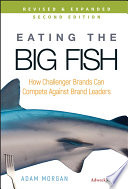

The central premise of 'Eating the Big Fish' revolves around the idea of challenger brands—those smaller, more agile companies that position themselves against industry giants. These brands often emerge in saturated markets where larger competitors dominate. The book argues that challenger brands can carve out a niche by leveraging their unique strengths, such as innovation, customer intimacy, and a strong brand story. By adopting a challenger mindset, these brands can disrupt established players and capture market share. The author emphasizes that it's not merely about being smaller; it's about having a distinct identity and purpose that resonates with consumers. This concept encourages businesses to focus on their unique value propositions and to embrace their underdog status as a strategic advantage.
Continue readingPositioning is a critical aspect of marketing, and 'Eating the Big Fish' delves into how challenger brands can effectively position themselves against larger competitors. The book outlines the importance of understanding the competitive landscape and identifying gaps that can be exploited. Challenger brands should aim to create a unique positioning statement that highlights what sets them apart from the giants. This involves not only defining their target audience but also articulating a clear brand message that resonates with consumers. The book provides frameworks and examples of successful positioning strategies, illustrating how challenger brands can communicate their value effectively and build a loyal customer base.
Continue readingOne of the key advantages of challenger brands is their ability to innovate and adapt quickly to market changes. 'Eating the Big Fish' emphasizes that while larger companies may have more resources, they often lack the agility to respond to new trends and consumer demands. Challenger brands can leverage this by fostering a culture of innovation and being willing to take risks. The book discusses various strategies for encouraging creativity within teams, from iterative product development to embracing customer feedback. By prioritizing innovation and maintaining flexibility, challenger brands can stay ahead of the curve and continuously meet the evolving needs of their customers.
Continue readingBuilding an emotional connection with consumers is essential for challenger brands, as it helps differentiate them from larger competitors. The book explores how successful challenger brands create authentic relationships with their customers through storytelling, shared values, and community engagement. By tapping into the emotional aspects of branding, these companies can foster loyalty and advocacy among their audience. 'Eating the Big Fish' provides insights into crafting compelling narratives that resonate with consumers on a deeper level, encouraging brands to be transparent, relatable, and purpose-driven in their messaging.
Continue readingCommunication plays a vital role in how challenger brands convey their identity and value to the market. The book outlines various communication strategies that can amplify a brand's message and enhance its visibility. This includes leveraging digital marketing, social media, and public relations to reach target audiences effectively. 'Eating the Big Fish' emphasizes the importance of consistency in messaging and the need to engage with consumers across multiple channels. By employing a multi-faceted communication approach, challenger brands can build awareness, drive engagement, and ultimately convert consumers into loyal customers.
Continue readingCommunity building is a powerful strategy for challenger brands, as it fosters a sense of belonging among consumers. The book highlights how successful brands create communities around their products or services, encouraging customer interaction and engagement. This sense of community not only enhances brand loyalty but also generates valuable feedback and insights for product development. 'Eating the Big Fish' provides examples of brands that have effectively built communities, illustrating the impact of customer participation on brand growth. By prioritizing community engagement, challenger brands can create advocates who actively promote their brand and contribute to its success.
Continue readingFinally, 'Eating the Big Fish' addresses the challenge of sustaining growth and momentum once a challenger brand has gained traction in the market. The book discusses strategies for scaling operations, expanding product lines, and maintaining brand integrity while pursuing growth. It emphasizes the importance of staying true to the brand's core values and mission, even as the company evolves. The author provides insights into balancing innovation with consistency, ensuring that the brand continues to resonate with its audience. This focus on sustainable growth is crucial for challenger brands looking to establish themselves as long-term players in their industries.
Continue reading